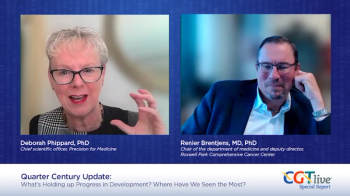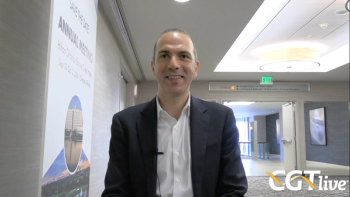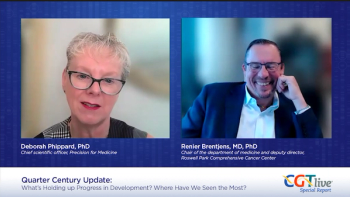
KTE-X19 Demonstrates Comparable Pharmacologic, Clinical Outcomes to Approved Therapies in MCL
The pharmacodynamic profile of KTE-X19, an autologous anti-CD19 CAR T-cell therapy, was associated with efficacy and treatment-related neurological events among patients with relapsed/refractory mantle cell lymphoma treated within the ZUMA-2 trial.
Michael Wang, MD
The pharmacodynamic profile of KTE-X19, an autologous anti-CD19 CAR T-cell therapy, was associated with efficacy and treatment-related neurological events among patients with relapsed/refractory mantle cell lymphoma treated within the ZUMA-2 trial, according to data presented at the 2020 American Society of Clinical Oncology (ASCO) Virtual Scientific Program.1
Additionally, when compared to currently approved therapies, KTE-X19 demonstrated comparable pharmacologic and clinical outcomes in patients with high-risk MCL characteristics versus lower-risk characteristics defined by tumor protein TP53 mutation or high Ki-67 proliferation index.
Patients who have these higher-risk characteristics, the researchers wrote, typically have poor prognosis when receiving standard therapies.
“KTE-X19 pharmacokinetic and pharmacodynamic profiles were generally comparable across lower and high-risk patients consistent with comparable clinical responses with a trend toward increased pro-inflammatory markers in patients with a mutated TP53,” Luhua (Michael) Wang, MD, a professor in the department of lymphoma and myeloma at The University of Texas MD Anderson Cancer Center, said in a pre-recorded presentation. “In addition, the pharmacodynamic profile of KTE-X19 was associated with the efficacy including early MRD status and grade 4 neurotoxicity.”
Results from the primary efficacy analysis of the ZUMA-2 trial demonstrated that patients with relapsed/refractory MCL — who had received 1 to 5 previous therapies — achieved an objective response rate of 93% (67% complete responses) after receiving KTE-X19. The results were generally comparable among patients with high-risk disease.
CAR T-cell levels in the blood were associated with objective response and toxicity.
To compare the pharmacological profile of KTE-X19 in lower- and higher-risk patients within ZUMA-2, Wang and colleagues conducted a comparative analysis and analyzed product attributes, CAR T-cell and serum cytokine levels in the blood, as well as any associations with clinical outcomes.
Additionally, the researchers wanted to characterize the pharmacodynamic profile of patients who achieved MRD-negative status by day 28 and who presented with a grade 4 neurotoxicity.
The study drug demonstrated a minimal bias toward CD8 and effector memory phenotypes, with a median CD4/CD8 ratio of 0.7; median naïve T-cell phenotype of 24.5%; median central memory T-cells of 12.8%; median effector memory T-cells of 24.5% and median effector T-cells of 28.7%.
MRD was analyzed in 29 of the available 68 patients. Of those 29 patients, 83% (19 complete response and 5 partial response) reached MRD negativity one month after receiving KTE-X19.
At one month following KTE-X19 treatment, patients who were MRD-negative had increased median cytokine levels of interferon (INF)-γ, interleukin (IL)-6, IL-15, IL-2, and IL-10. The levels, according to the data, peaked in the serum within 7 days of treatment.
Patients who were MRD negative by the first month after treatment also had increased median peak levels of Granzyme B and soluble programmed death-ligand 1 (PD-L1).
Six patients developed neurologic events that were labelled as grade 4 in severity, including one case of cerebral edema. Three of those patients developed concurrent grade 4 cytokine release syndrome.
This subgroup of patients had higher peak serum levels of INF-γ, tumor necrosis factor alpha (TNF-α), monocyte chemoattractant protein-1, IL-2 and IL-6 than patients without any grade 4 neurologic events.
“Altogether, this pharmacological data supports the concept of CAR T-cell therapy being able to overcome MCL disease with poor risk factors,” concluded Wang.
Wang M, Rossi JM, Munoz J, et al. Product characteristics and pharmacological profile of KTE-X19 in patients (pts) with relapsed/refractory (R/R) mantle cell lymphoma (MCL) in the phase II registrational ZUMA-2 trial. Presented at: 2020 ASCO Virtual Scientific Program. Abstract 3023.
Newsletter
Stay at the forefront of cutting-edge science with CGT—your direct line to expert insights, breakthrough data, and real-time coverage of the latest advancements in cell and gene therapy.










































